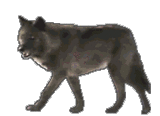|

Removing federal protections for gray wolves could expose wolves in the
to aerial gunning, poisoning and trapping.
Gray wolves in the Great Lakes have lost Endangered Species Act protections, with the Bush administration also pushing
to remove federal protection for wolves in the northern Rockies within the year.
Endangered Grey WolfManagement of wolves in the Great Lakes was turned over to the states of Minnesota, Wisconsin and
Michigan in March. The same could happen with states in the northern Rockies, even though officials in Idaho and Wyoming intend
to kill the majority of the wolf population there.
"The U.S. Fish and Wildlife Service decision is cause for both celebration and alarm, as the Great Lakes and the
northern Rocky Mountain states have very different outlooks on how to manage the wolves after de-listing," says Defenders’
President Rodger Schlickeisen.
The Great Lakes gray wolf population has increased from fewer than 1,000 in the early 1970s to about 4,000 wolves today.
"Minnesota, Wisconsin and Michigan have shown their commitment to wolf conservation while under federal protection and
are ready to assume management for the state populations," says Defenders’ Gina Schrader.
But the case is different in Idaho, where Gov. C.L. "Butch" Otter has publicly announced that the state will
seek to kill more than 75 percent of the state’s wolves through large-scale hunting and aerial-gunning programs.
And in Wyoming, the state would allow 16 out of the existing 23 packs of wolves in the state to be killed on sight-through
the use of poisoning, trapping and shooting on 90 percent of the wolf’s current home range outside of national parks.
"Instead, these two states should take a cue from Montana, which has a conservation-oriented management plan for
wolves in their state," says Suzanne Stone, Defenders’ northern Rockies representative.
Gray wolves were reintroduced into the northern Rockies a decade ago and now number more than 1,200 there. De-listing
wolves in this region would mean removing federal protections not only in Idaho, Montana and Wyoming, but in eastern Washington
and Oregon and a portion of northeastern Utah-before wolves are even restored in those states. The decision to de-list wolves
in the northern Rockies is yet another example of the Bush administration’s assault on federal environmental protections,
conservationists point out.
"Prematurely removing protection for wolves jeopardizes one of the most successful wildlife restoration efforts in
U.S. history," says Schlickeisen. "Killing hundreds of wolves needlessly is persecution, not responsible wildlife
management."
|

